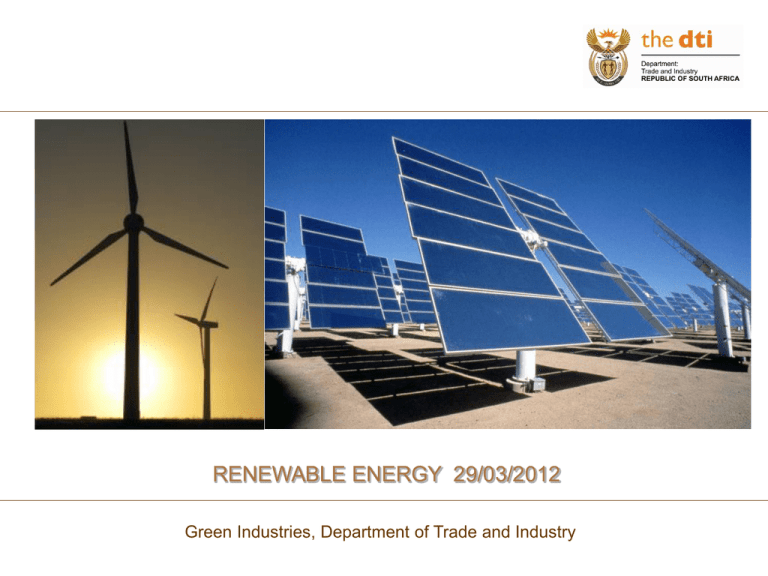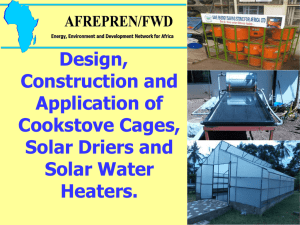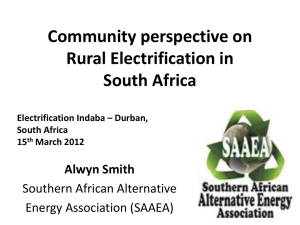Challenges - unido spx
advertisement

RENEWABLE ENERGY 29/03/2012 Green Industries, Department of Trade and Industry RENEWABLE ENERGY IN SOUTH AFRICA • REIPPPP – Procurement of 3725MW of RE over 3-5 bid submission windows • Industrial Policy Action Plan – Prioritizes green industry as an emerging economic growth sector • Wind Industrial Strategy – investigation in to the development of the strategy for wind industry development • Solar and Wind Sector Development Strategy • Integrated Resource Plan (IRP) 2010-2030 MANUFACTURING CAPACITY FOR WIND ENERGY • South Africa’s wind-turbine and component manufacturing industry is still in its infancy • Small wind turbines – Kestrel Wind Turbines (0.6kW to 3kW in size) – Aero-Energy • Medium/large grid connected wind-turbine generators – PalmTree Power (300kW) • Large grid-connected wind turbines – limited quantities of components for this market sector LOCALISATION POTENTIAL SOLAR ENERGY - CSP CSP Value Chains • Materials: steel, plastic, copper, brass, aluminium, concrete, silica, molten salt and synthetic oil. While these can be sourced globally, many materials (including steel, plastic, aluminium, concrete and potentially synthetic oil) is available in South Africa •Components: for the collector system, steam generator system, heat storage system and electrical/control system. Many of these can be manufactured by South African engineering, aerospace and automotive companies •Construction/assembly: most of the construction can be done by SA companies CSP Localization Potential Solar PV Solar PV •In South Africa, photovoltaic systems are all small scale (less than 1 MW) mainly for off-grid applications. •Applications have included the telecommunications, game farms, schools, rural households, health centres, isolated lodges, navigational buoys, and other such applications, at a total capacity of 21 MW •IRP 2010 - 8 400 MW target for PV •Two solar PV plants in the Western Cape – Tenesol – Solar direct Solar PV localisation potential • South Africa bears potential for local production of several components that make up a solar PV plant including: – Module – Inverters, – Tracking systems – Steel structures – Cabling – Transformers REIPPPP • RFP announced 31 July 2011 – Wind: – PV: – CSP : 1 850MW 1 450MW 200MW Rolled out over a series of rounds • Round 1 – 53 bids received amounting to 2123 MW – 28 Preferred bidders amounting to ……MW • Wind = 934 • Solar PV = 1039 • Solar CSP = 50 – Round 2 submitted in March 2012 and Round 3 in August 2012 The role of the dti • Industry Development • Focus on localization of technologies – Set targets and monitor local content of RE projects – Local manufacturing – Incentivizing industry for local manufacturing of components – National standards are established for solar and wind power, ideally based on international standards – A facility is established for testing and certification of solar and wind power products – TISA promotes South African products and services in the solar and wind power sector. LOCAL CONTENT REQUIREMENTS Technology Onshore Wind Solar Photovoltaic Solar CSP Without Storage CSP with storage Biomass Biogas Landfill gas Small scale hydro Local Content Second Bid Submission Date First Bid Submission Date Current Current Threshold Target 25% 45% Third Bid Submission Date Threshold Target Threshold Target 25% 60% 40% 65% 35% 50% 35% 60% 45% 65% 35% 50% 35% 60% 45% 65% 25% 45% 25% 60% 40% 65% 25% 25% 25% 25% 45% 45% 45% 45% 25% 25% 25% 25% 60% 60% 60% 60% 40% 40% 40% 40% 65% 65% 65% 65% 25% 45% 25% 60% 40% 65% EMERGING ISSUES • Definition of local content – How deep into the value chain do we go – Value add percentages part of local content? – Increased threshold realistic? – Capacity of local suppliers • Volumes • Meeting the quality specifications • Experience – Price CHALLENGE TO SUPPORT LOCALISATION •Challenges –Do we have local suppliers? –Are local suppliers competitive? –Will local suppliers behave in monopolistic way once local content increases? –Local content vs value for money – Economical competitiveness of local module production •Threats –If we do nothing local industry will not develop beyond point of natural localization CONCLUSION •We are doing this for SA – Jointly seek solutions to reduce risk on the programme, developers and industry • A national commitment to renewable energy • Establish the demand for investment • Development of a strong, competitive domestic manufacturing industry, • Capability to compete with imports from an already established global industry • Additional incentives required Thank you Witness Mokwana wmokwana@thedti.gov.za Tel: +27 12 394 3508











